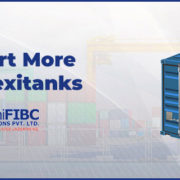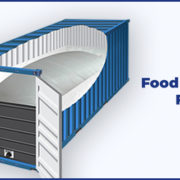Flexitanks are the latest food grade iteration in the development of bulk liquid storage and distribution containers for non- hazardous liquids. A flexitank is a mass fluid storage compartment whose walls comprise of different layers of polyethylene. The internal walls are made of adaptable polyethylene while the external walls are made of a more grounded joined material called polypropylene. Since the mass of a flexitank is flexible, it makes sense that it requires an outside design to help it when it has been topped off with a fluid. By utilizing previously existing standard steel containers, Flexitanks are giving a more secure, better, and more savvy option in contrast to modified delivery big containers for mass fluid transportation. However the requirements for Flexitanks vary from industry to industry depending on their types of fluid and their properties. On a detailed introspection it is thoroughly clear that Flexitanks because of its quality and specification contributes by large to Pharmaceuticals Wine, Agriculture, and Petrochemical industries. It is because of this large scale demand of Flexitanks across such wide variant of industries, because of its specifications and its application across storage and transportation Flexitanks in a way accounts for economies of scale.
There are many different mannerisms for economies of scale when it comes to a single product defining the effect. It is because of this reason an introspection across flexitank’s production to its market demand will help us analyze how Flexitanks accounts for economies of scale.
Let’s take a look at what economies of scale is and Flexitank allows economies of scale for different industries!
What is Economies of Scale?
An economy of scale is referred to as cost advantage that is experienced by an organization when it increases its level of output. This advantage usually happens because of the inverse relationship between per-unit fixed cost and the quantity produced. The greater the quantity of output produced, the lower the per-unit fixed cost. Economies of scale also result in a fall in average variable costs (average non-fixed costs) with an increase in output. This is brought about by operational efficiencies and synergies as a result of an increase in the scale of production.
Economies of scale are usually realized by an organization at any stage of the production process. Where the term, production refers to the economic concept of production and involves all activities related to the product, not involving the final buyer. Thus, a business can decide to implement economies of scale in its marketing division by hiring a large number of marketing professionals. A business can also adopt the same in its input sourcing division by moving from human labor to machine labor.
This turnaround of proportionate saving in costs by an organization while gaining by an increased level of production can be defined as economies of scale in layman’s term for an organization. The process of economies of scale thus achieved by an organization can come from many different factors, dividing the process of economies of scale into many variant.
Identification of Economies of Scale Variant
Based on the understanding derived as per the economies of scale there are four variant of economies of scale that puts an organization in an advantageous position they are as follow:
- Technical
- Managerial
- Financial
- Commercial
Each of these economies of scale provides an organization with a subjective edge that puts them ahead of the market competition and curve.
In the context of organization’s dealing in fluid business these economies of scale could also be achieved by the organizations with the usage of Flexitanks. Let’s take a look at how flexitank contributes to each of the economies of scale factors for an organization.
Achieving Economies of Scale with Flexitanks
There are many different ways Flexitanks contribute to economies of scale, for each of the identified economies of scale let’s highlight how usage of flexitank can account for that added advantage:
Technical Economies of Scale
The technical economies of scale highlight technical specifications that are contributed by the Flexitanks to an organization. One of the primary understandings is the limit of capacity of the Flexitanks that is one of the significant focuses to be taken into consideration when it comes to technical aspect. The bigger is the capacity limit, the more noteworthy is the flexibility to push production, since storage and transportation would not act as a major challenge. This showcases that Flexitanks allow you to store and transport a larger capacity of liquid than regular tanker based on pre-decisive decision on the flexitank size without any hassle at a much cheaper cost and work load. This increased limit from 16,000 to 24,000 liters for Flexitanks and its ability to be used for 20 – 24 feet containers, clearly provides an organization with the technical to economies of scale with the usage of flexitank for the purpose of storage and transportation.
Managerial Economies of Scale
The managerial economies of scale highlight the managing possibilities of a flexitank for the purpose of storage and transportation. One of the primary aspects that accounts for managerial economies of scale possibilities comes from the easy handling of leaks or protection from leaks of a flexitank. The insight of leaks highlights if a flexitank breaks or spill liquid, the expenses of cleaning up the spill can be far more than the worth of the lost liquid itself. Liquid spills can also result in critical human injury and natural harm. Therefore, it is critical to take precautions to minimize and contain leaks when using a tank to store liquid for transportation. It is because of this reason the manufacturing’s of Flexitanks takes into account possibility of leakage and hence are manufactured using double layered of polypropylene and polyethylene, resulting development of a tank almost proof to leakage. However accidental leakages can happen and hence Flexitanks provides flexibility of assembling it in a manner that the leakage does not causes challenges for business. As a thumb rule, control around the flexitank can be set up utilizing a spill embankment covering beneath and around the flexitank. On the other hand, the option to put the flexitank on top of a dribble plate to contain little leaks is also an ideal solution. These flexibilities are not offered by other containers making Flexitanks ideal for bulk liquid transportation. This active flexibility of Flexitanks ensures managerial economies of scale for the organization, placing them in an advantageous position.
Financial Economies of Scale
The financial economies of scale focus on the financial advantage acquired by the organization with their product. The usage of flexitank clearly showcases how it can help organization save money through bulk production because of technical advantages, further it also benefits organization financially based on the protection against leaks, other than these with added advantages curved in with re-usability of flexitank and protection of the fluid stored inside for a longer period of time without getting damaged, it is clearly evident that usage of flexitank provides large scale financial advantages to an organization. This in turn account for financial economies of scale for the organization with the usage of Flexitanks.
Commercial Economies of Scale
The commercial economies of scale highlight edge on commercial aspect of a business from market competition. This takes into account the commercial gains that flexitank provides an organization. These usually come from two major factors they are chemical compatibility and temperature control that is provided by the flexitank. The chemical compatibility and temperature control makes the Flexitanks ideal for storage of fluid for a long period of time as well as long voyages of transportation without having to worry about the product being damaged in the transit or storage because of change in temperature. This in turn adds commercial value to the business especially during transportation where delay in transit is common factor. In such cases usage of other tanks can actually impact the quality of the product. It is because of this reason the chemical compatibility and temperature control put the Flexitanks in a much larger advantageous position when it comes to commercial value, thus allowing the organization enjoy commercial economies of scale in the process.
The contribution of flexitank to each of the economies of scale clearly indicate the wide curve of advantage it can provide an organization with when it comes to larger volume of production to achieve economies of scale. So if you are into fluid or liquid business and are looking for a perfect solution for storage and transportation of your product then Flexitanks are your solutions. It will not only provide you with the perfect resolution but will also help your business gain competitive advantages in the market through various economies of scale.
To know more about Flexitanks and how it can help your business gain economies scale get in touch with us at Fluid Flexitanks.
Why Choose Us?
Fluid Flexitanks manufactures’ premium quality Flexitanks that is ideally suited for storing and transportation of all types of fluid. The Flexitanks are manufactured by adhering to all the set standards so that none of the users get even a single chance to complain about our products. With several years of experience and expertise, Rishi FIBC is one of the industry leaders in manufacturing Flexitanks that can help you boost you fluid business, while giving you that competitive edge through various economies of scale. For business enquiry please contact us to know more about Flexitanks.
FAQ
1. What are flexitanks used for?
Flexitanks are used for transporting bulk liquids such as edible oils, chemicals, wines, and industrial fluids. They replace traditional containers like drums or IBCs, offering a more efficient and cost-effective solution.
2. How do flexitanks help achieve economies of scale?
By maximizing container space and reducing packaging waste, flexitanks allow shippers to transport larger volumes per shipment. This lowers the cost per unit and improves overall logistics efficiency.
3. What types of liquids can be shipped in flexitanks?
Flexitanks are suitable for non-hazardous liquids including:
- Vegetable oils
- Fruit juices
- Wine
- Latex
- Non-hazardous chemicals
4. Are flexitanks environmentally friendly?
Yes. Flexitanks reduce the need for secondary packaging and are often recyclable. Their lightweight design also contributes to lower fuel consumption during transport.
5. Can flexitanks be reused?
Most flexitanks are designed for single use to ensure hygiene and prevent cross-contamination. However, some manufacturers offer multi-use options depending on the liquid type and logistics setup.
6. How much liquid can a flexitank carry?
A standard flexitank can carry between 16,000 to 24,000 liters of liquid, depending on the container size and product density.
7. What are the cost benefits of using flexitanks over traditional packaging?
Flexitanks eliminate the need for drums or IBCs, reduce labor costs, and increase payload capacity. This leads to significant savings in shipping and handling.
8. Are flexitanks safe for international shipping?
Yes. Flexitanks comply with international shipping standards and are tested for durability, leakage prevention, and compatibility with various liquids.
9. What industries benefit most from flexitank solutions?
Industries such as agriculture, chemicals, food and beverage, and industrial manufacturing benefit from the scalability and cost-efficiency of flexitanks










